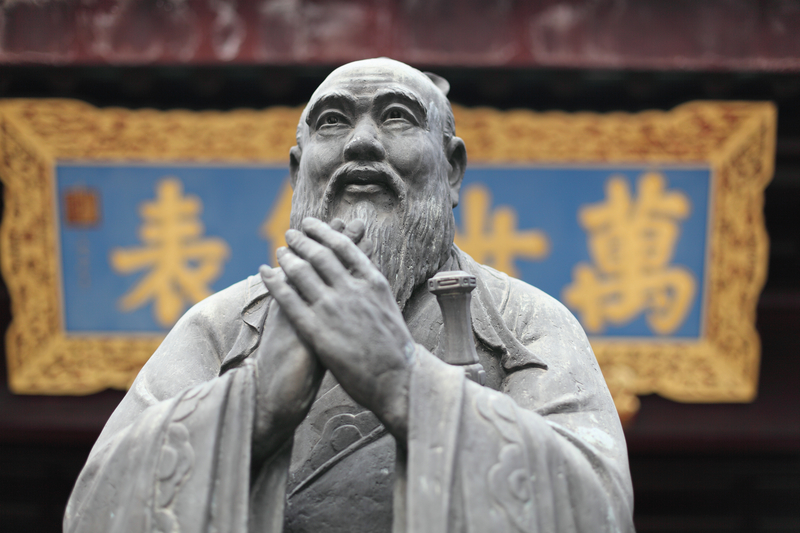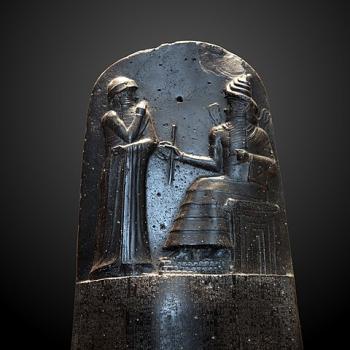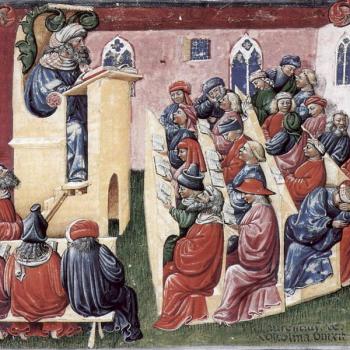The Axial Age was a period of world history. It’s called “Axial Age” because it was a pivotal time, a turn on an axis, in religion and philosophy. The oldest of our great world religions became what they are today in the Axial Age. The first of the great philosophers whose work still shapes civilization lived in the Axial Age.
The phrase “Axial Age” was coined by the German philosopher Karl Jaspers (1883–1969), in his book Vom Ursprung und Ziel der Geschichte (The Origin and Goal of History), published in 1949. Jaspers argued that such an Axial Age must involve all of humankind, and must be “that point in history where man first discovered the notion of himself that he has realized since.”
A Turning Point
“Such a historical axis, or turning point, seems to be situated in the years around 500 BCE, in the intellectual development that took place between 800 and 200 BCE,” Jaspers wrote. “There lies, it appears to me, the most crucial turning point in history; it was then that man as he is today was born. Let us, for the sake of brevity, refer to this period as the ‘axial age.'”
I acknowledge that the Axial Age theory is not actually global. It focuses mostly on Asia and on Mediterranean civilizations of the time, especially Greece. Also, the dates given for it are a bit fluid. Sometimes it’s 900 to 300 BCE; sometimes 800 to 200 BCE; and sometimes it’s focused more tightly on 500 to 300 BCE.
And I acknowledge that the Axial Age was trendier a few years ago than it is now. Some in academia have dismissed it as being too “woo.” Claims were being made that it represented some kind of spontaneous expansion of consciousness in the human species. But let’s put that aside and look at what happened in the Axial Age.
What Happened in the Axial Age?
This was a time in which humans became more analytical and reflective. At about the same time, while scattered across vast distances, some remarkable individuals introduced the beginnings of philosophy and science. Ideals about compassion and universal love first emerged.
It’s a remarkable thing that so many of the giants of human civilization were alive at about the same time. Confucius of China and Gautama Buddha of India both lived, we believe, in the 6th to 5th century BCE. Laozi, author of the classic Daode jing (Tao te Ching), was said to have been a contemporary of Confucius. The early Greek philosophers Xenophanes, Heraclitus, and Democritus also were alive at this same time. Socrates was born in the 5th century BCE and died at the beginning of the 4th.
This was also a time in which older religious traditions, notably Judaism and Hinduism, underwent significant change. For example, earlier Judaism was not genuinely monotheistic; the God of Judaism was one god among many. Historians tell us that true monotheism, the proposal that there is only one God, emerged in about the 6th century BCE.
Take Vedanta, for Example
One example of the axial shift: In the 1st millennium BCE, the tradition that today we call Hinduism entered a phase called “Vedanta,” which means “end of the Vedas.” The Vedas are the earliest scriptures of Hinduism. The oldest, the Rig Veda, dates to at least 1200 BCE and is possibly much older. But in the 1st millennium BCE new scriptures emerged called the Upanishads. The principle Upanishads are believed to have been composed between 800 and 300 BCE.
Why is this significant? The Vedas are primarily concerned with correct ritual and the propitiation of the gods. This was important to ensure blessings instead of disaster if the gods were displeased. The Upanishads, however, show their authors reflecting deeply on the reality beyond the rituals, and asking questions that we still ask today. What is the fundamental nature of existence? What is the fundamental nature of the self? And what is the relationship of an individual being to the vast, unknowable cosmos?
Hinduism as we know it today was very much shaped by the Upanishads as well as by the epic poems the Ramayana (ca. 300 BCE) and the Mahabharata, which includes the exquisite Bhagavad Gita (ca. 3rd-2nd century BCE), one of the jewels of the world’s religious literature. These poems reflect and expand upon many of the teachings presented in the Upanishads.
New Ideas About Morality
The answers proposed by the far-flung Axial Age thinkers were not necessarily identical, expecially in regard to the physical world. But one shift that emerged in many different places is a change in how people thought about morality. Earlier codes of morality — for example the Ten Commandments, traditionally dated to 1300 BCE — emphasized obeying particular rules. Axial Age writers and thinkers for the first time emphasized the importance of compassion. Rules and rituals were still important, but so is humaneness and kindness.
For example, Confucius taught that the five qualities of a good person are benevolence, righteousness, ritual propriety, wisdom, and trustworthiness. The Buddha emphasized four sublime virtues — compassion, loving kindness, sympathetic joy (joy for the good fortune of others; sometimes this is shortened to “empathy”), and equanimity, avoiding extremes and staying balanced in the midst of difficulty. Cultivating these qualities, making them part of yourself, took ideas about morality beyond just obeying rules.
There also was a new emphasis on self-discipline in the Axial Age. People had recognized that self-gratification, wealth, and power can cast shadows. Greed is not good if it causes others to do without. Virtues like kindness, generosity, and moderation are qualities that allow people to live together harmoniously and create sustainable communities.
The Golden Rule
Most Axial Age religions and philosophies proposed some variation of the Golden Rule — treat others as you would like to be treated. A variation of the Golden Rule found in the Torah — “You shall love your neighbor as yourself,” Leviticus 19:18 — might be older than the Axial Age. Leviticus describes events dating to the 14th century BCE, and some parts of it could be that old. But scholars today say it reached its current form during the Persian Period, 538 to 332 BCE.
It’s not always phrased the same way, but the basic principle of the Golden Rule appears to have become nearly universal during the Axial Age or immediately after. It’s found in the Analects of Confucius. It’s stated several different ways in early Buddhist scripture. It’s in the Daode jing of Daoism and the Mahabharata of Hinduism. Thales of Greece (ca. 624–546 BCE) said, “Avoid doing what you would blame others for doing.”
How Did This Happen?
It is sometimes argued that these commonalities appeared because all religions come from the same common source, some ur-religion from unknowable antiquity. But if that were the case, we’d have seen all these commonalities a lot sooner, at least by the Bronze Age (ca. 3300 to 1200 BCE), a period that left enough records. Instead, we see them arise spontaneously in many different places, all roughly in the middle of the 1st millennium BCE.
It’s probably the case that ancient people traveled around more than we realize. It’s not impossible there were some Axial Age contacts between India and China that we don’t know about. Historians propose there were trade routes between Mesopotamia and the Indus Valley in what is now Pakistan as early as 3000 BCE.
But as far as I know, significant cross-pollination between far-flung Old World cultures wasn’t that common before Alexander the Great (356–323 BCE) charged across Asia, leaving a swath of Hellenic civilization in his wake. The edicts of Ashoka of India, who reigned from 268 to 232 BCE, have been found as far west as Kandahar, Afghanistan, written in Greek. Silk Road trade began in 130 BCE, and in time there was a vast network of trade routes connecting China to the Roman Empire. There were places in central Asia, ca. 200 BCE through the early centuries of the 1st millennium CE, where Greek, Persian, and Indian cultures mingled.
But that was after the Axial Age had concluded. So we can’t say for certain why it happened, just that it did.














